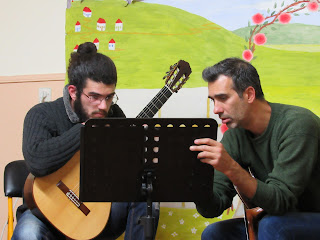
On Saturday, December 2, 2017, George Bechlivanoglou held, for the second consecutive year, an outstanding guitar seminar for the members of the RGE in Rodotopi. On the following day, Sunday, December 3, 2017, he continued at Frontzou Politeia in Ioannina with a lecture and guitar seminar.
The two-day event of George Bechlivanoglou in Ioannina, as well as two previous ones, was organized by the Pavlos Vrellis Museum of Greek History, following the initiative of Konstantinos Vrellis, to whom our association expresses its heartfelt gratitude for his contribution.
The title of George Bechlivanoglou’s lecture was “Musical Notation – Implications and Interpretation.” He analyzed aspects of musical writing: what cannot, or is not practical, to be written, how it is implied, and how its understanding decisively influences the performance and interpretation of a musical work. This lecture was relevant to all musicians and performers, regardless of instrument.
Here is an introduction to the subject, as given by him:
The same applies to the notation and depiction of musical thought. The mind of the composer imagines, thinks, and then puts it on paper. But to what extent can one capture music exactly as imagined? Anyone who has tried to write down even a small piece of their own composition has surely felt the limitations of notation. One has certainly tried in different ways to get as close as possible to their true thought, only to accept in the end that some things cannot be written but merely implied. Thus, hopes rest on the performer, who, upon undertaking the work, will perceive and interpret accordingly.













